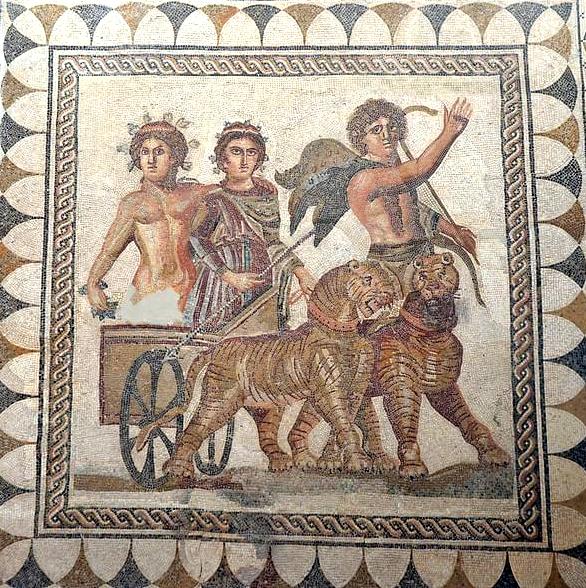Themes
"Men on an endless journey, with no heroes or villains, no monsters or gods.
Just life. In the gutter, not the stars."
Petronius
You can find almost every aspect of human existence in The Satyricon, although some themes are more obvious while others are buried deep in the narrative. Starting at the top
and burrowing down, we have:
Epic / Picaresque
An epic was originally a long poem that narrated the deeds and adventures of a hero or heroes, real or mythological. In classical times there were
The Odyssey and The Iliad (by Homer, in Greek) and The Aeneid (by Virgil, in Latin). In English we have
Le Morte d'Arthur (1485), The Faerie Queen (1590-96) and Tolkien's The Lord of the Rings (1954-55).
Modern epics seldom include monsters and gods or far-off days or lands; James Joyce's Ulysses (1922) sets Homer's Odyssey in contemporary Dublin. Whether or not every new title today described by its publisher as "epic" deserves the term is something that future generations will decide.
Epics deal with heroes, while picaresque (from the Spanish for rogue or bohemian) stories concern themselves with anti-heroes, who combine love of life with elements of trickery and dishonesty. To modern eyes The Satyricon is picaresque not epic, but, given that all educated Romans would have been aware of The Odyssey, it is tempting to think that Petronius had that tale of wandering heroes in mind when setting Encolpius and his companions off on their endless journey.
Satire
Satire uses various forms of humour (ridicule, irony, exaggeration etc) to poke fun at individuals or a group of people. The many satirists in classical times range from Aristophanes (Greek) to Juvenal and Apuleius (Roman). Near the top of the list comes Petronius, whose memorable characters include the rhetorician Agamemnon, who tells the Forum where Roman education has failed, the wealthy Trimalchio, whose feast is a never-ending parade of exotic foods and entertainments, and the impoverished and lecherous poet Eumolpus. When the satire fades into the background, it is usually to give way to episodes of . . .
Satyre* / Desire
A satyr is a drunken, lustful woodland spirit, half human, half goat - think Narnian faun with a leer and a prominent phallus. There are no satyrs in The Satyricon but much of the story is driven by sex - sex between men, sex between men and women, sex sought, sex offered, sex denied, sex imposed and the frustration of impotence.
To modern eyes the frequent sexual activity in The Satyricon is both familiar and foreign - we know what is going on, but it sometimes takes place in situations and between individuals that today would not be acceptable. Our biggest challenge in adapting Petronius' work is presenting these scenes in a way that combines both the first and twenty-first century points of view.
* No, you won't find that word in a dictionary, but we think you should.
Bromance & Love
Outsiders can never know the true nature of the emotion that binds two people in a strong friendship or intense love affair.
We must limit ourselves to what we observe.
We see that the relationship between Encolpius and Ascyltos is as strong
as any modern bromance as the pair fight and argue and separate and come together again, but we can only guess
what quality each sees in the other. Nor can we be sure how much Giton cares for Encolpius; which of the two is
the lover with the greater need for the other and which is the beloved who, consciously or not, determines the course of the affair?
And why does Ascyltos constantly attempt to seduce Giton?
Whatever emotion binds these three young men to each other, it is the driving force at the heart of The Satyricon.
|
|

Are these three in a mosaic in Lebrija Palace, Spain, our (anti-)heroes? Almost certainly not, but they look like good companions
|
Between the Sexes
For ancient Romans there was no distinction between physical sex and social gender. Our version accepts that perception but looks at it with twenty-first century eyes. Not every man you see on stage will be male and not every woman female and some may be neither...
As for the relative status of men and women in Roman society, we can only say that Petronius deals in individuals, not groups, and the women in The Satyricon are as likely to be as domineering and powerful as the men.
Finally . . . the Missing Theme
The text that has survived of Petronius' story does not have an ending and our heroes almost certainly had more adventures than the ones we know. Our version, however, must come to an end
and it does so in the present day. It is then we reveal the Missing Theme - although we hope the audience will have been aware of it all the way through.
What is that theme? You don't expect us to tell you, do you? Come see for yourselves and decide if you agree with our take on this eternal classic.
|
|
Not currently scheduled
* previous productions *
* request a licence *
Script

£10.99
free UK postage


supporting amateur theatre
|




